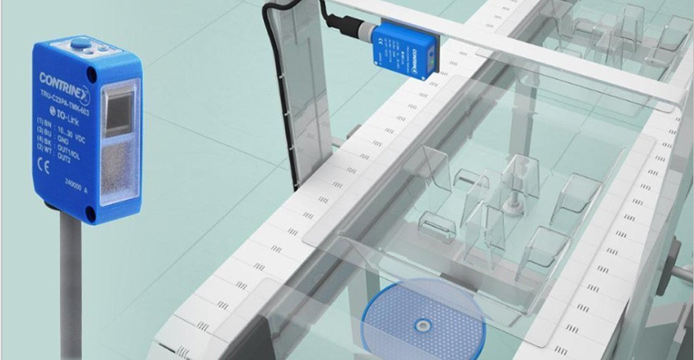
Posted to News on 25th Sep 2023, 15:37
Transparent-object-detection sensors give a blistering performance

Contrinex’s patented UV-light-based transparent-object-detection sensors provide consistent sensing across targets, even thin and transparent films. They have proven their worth for a company manufacturing high-volume blister packs.
Thermoformed trays and blister packs are widely used in packaging and increasingly these are formed from transparent material, which is often considered to give a premium appearance to the product within the packaging. The thermoforming manufacturing process is very fast and low-cost with the plastic trays being formed from continuous rolls of sheet material.
A reflex sensor detects each set of trays, blister or formed shape, when they interrupt it’s view of a reflector. This becomes much more difficult with transparent items, because it is much harder to detect the formed shape, even when specialist transparent-object-detection sensors are used. Despite being optimised for this application, on each different production batch, the sensors tend to need to be adjusted to detect the thicker front and rear edges of the shape which have been formed.
Contrinex offers both standard transparent-object-detection sensors which use visible light, and a unique, patented solution which uses Ultraviolet (UV) light. A user of a thermoforming machine was keen to use the UV-light-based sensor because of its much more consistent and robust switching because UV light is absorbed by transparent plastic and glass objects, not just the thicker edges.
Thermoforming machines are deployed in packaging lines across a wide range of industries from pharmaceuticals to food and beverage. They produce high-volume blister packs, film-sealed trays and semi-rigid bases into which products are loaded before being presented in outer packaging. All types consist of a semi-rigid, formed recess which is thermoformed at high speed from a large reel of sheet-material.
Once formed the continuous strip of trays is passed to slitting and cutting stations within the machine. Sensors must reliably detect the presence of the formed elements to accurately trigger the subsequent operations. To enhance the robustness of the sensing, typically a reflex sensor is used to look at a reflector and detects the presence of each formed tray as it passes at speed.
Detecting transparent trays is considerably harder and whilst specialist transparent-object-detection sensors are used, they require adjustment to tune them to each production batch. Contrinex developed a unique solution which uses Ultraviolet rather than visible-light to provide a much more robust, reliable and consistent detection. This is because UV light is blocked by plastic and glass even if it is clear and thin, enabling the sensors to provide a consistent detection across the entire formed shape. Additionally, they do not require adjustment between manufacturing batches which improves the machines availability and throughput. The ability to remove the need for manual intervention is especially attractive in food and pharmaceutical packaging environments, where high hygiene regimes are in place.
Contrinex’s small, powerful C23PA UV transparent-object detection sensors proved to be ideal for this application. At only 20mm x 30mm x 10mm, with a long sensing distance of 1.2m, and auto-collimated optics that ensure there are no blind zones, these sensors were easy to mount inside the machine to detect the presence of the formed shapes.
The sensor uses a patented reflex operating principle with polarised ultraviolet light with a 275nm wavelength. This wavelength maximises the absorption of the polarised UV light by a range of commonly used plastics, to optimise the sensor’s performance. The sensor also benefits from being resistant to interference from dust, liquid droplets and splashes, which commonly disturb transparent-object-detection sensors. Custom-designed reflectors use high-technology plastics to provide both excellent reflective properties and resistance to ageing by UV-light.
The customer was upgrading an existing machine and so took advantage of an option of the sensor which offered a second switched output for the ‘stability alarm’. This preventative maintenance function which is also available over IO-Link, signals when the sensor sees 20 consecutive poor detections, and is disactivated by 20 consecutive good detections. Whilst the sensor and the machine continue to work normally, the ‘stability alarm’ forewarns of a problem, and hence is sometimes referred to as the “come, clean me” warning output.
The sensors which are Ecolab-certified are available with choices of PNP/NPN, Light-on/Dark-on, Cable or Socket, and can be adjusted using a teach button or IO-Link. They exceeded the customer’s need for reliable operation with little or no manual intervention and so were highly cost-effective.
These sensors are part of the C23PA family of photoelectric sensors, which also include conventional visible-light-based transparent-object-detection, plus the other four photoelectric sensing technologies, to give designers a wide choice of interchanged sensors.






